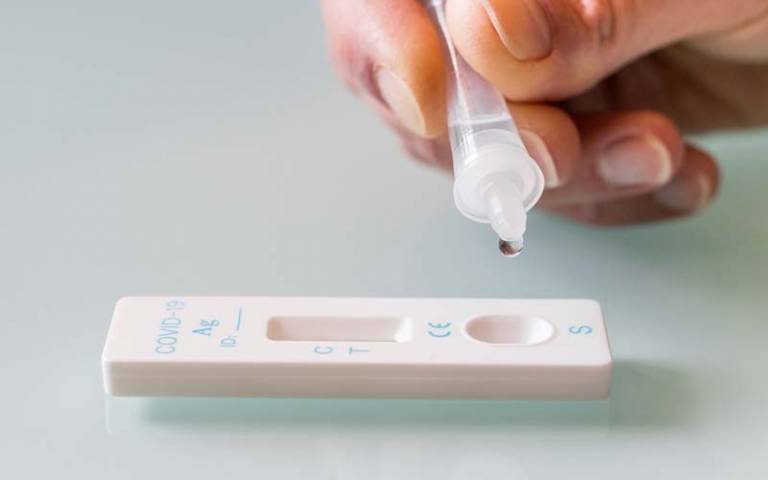Immune response study explains why some people don’t get Covid
19 June 2024
High levels of a key gene in volunteers who managed to fight off infection quickly suggests it has a protective effect against SARS-CoV-2, according to a new study from researchers at UCL, the Wellcome Sanger Institute and Imperial College London.

The study, published in Nature, provides the most detailed view of how the body responds when exposed to an infectious disease. The researchers used single-cell sequencing technology to observe immune responses against SARS-CoV-2 infection in healthy adult volunteers, as part of the COVID-19 human challenge study1. Not all exposed participants went on to develop a COVID-19 infection, allowing the team to uncover unique immune responses associated with resisting sustained viral infection and disease.
SARS-CoV-2 has infected millions of people across the world since the beginning of the COVID-19 pandemic in 2019. While it is potentially fatal, many people who came into contact with someone who had tested positive for COVID-19 have managed to avoid getting ill themselves, whether remaining negative on PCR testing or having an asymptomatic case of the disease.
While previous studies have examined COVID-19 patients after the onset of symptoms, for the first time researchers have been able to document immune responses from the exact moment of exposure to the virus.
As part of the UK COVID-19 Human Challenge study with Imperial College London, 36 healthy adult volunteers without previous history of COVID-19 were administered SARS-CoV-2 virus through the nose.
Researchers performed detailed monitoring in the blood and lining of their noses, tracking the entire infection as well as the immune cell activity prior to the infection event itself for 16 volunteers. The teams at the Wellcome Sanger Institute and UCL then used single-cell sequencing to generate a dataset of over 600,000 individual cells.
Across all participants, the team discovered previously unreported responses involved in immediate virus detection. This included activation of specialised mucosal immune cells in the blood and a reduction in inflammatory white blood cells that normally engulf and destroy pathogens.
Individuals who immediately cleared the virus2 did not show a typical widespread immune response, but instead mounted subtle, never-seen-before innate immune responses.
The results suggest that high levels of a gene called HLA-DQA2 before exposure helped people prevent a sustained infection from taking hold. People with high levels of this gene cleared the virus so effectively that they didn’t return a positive PCR test at all and had no symptoms, while another group tested positive intermittently and had very mild symptoms.
In contrast, the six individuals who developed a sustained SARS-CoV-2 infection exhibited a rapid immune response in the blood but a slower immune response in the nose, allowing the virus to establish itself there.
The researchers further identified common patterns among activated T cell receptors, which recognise and bind to virus-infected cells, offering insights into immune cell communication that could potentially be useful for developing targeted T cell therapies against COVID-19 and other infectious diseases.
Dr Kaylee Worlock, co-first author of the study from UCL Division of Medicine, said: “Studies so far have only offered a snapshot of what is going on during COVID-19, whereas our approach allowed us to study the evolution of infection in three distinct infection groups prior to and during infection, right through to the resolution, in unprecedented detail.”
Dr Marko Nikolić, senior author of the study and Honorary Consultant in Respiratory Medicine from UCL Division of Medicine, said: “These findings shed new light on the crucial early events that either allow the virus to take hold or rapidly clear it before symptoms develop. We now have a much greater understanding of the full range of immune responses, which could provide a basis for developing potential treatments and vaccines that mimic these natural protective responses.”
This study is part of the Human Cell Atlas initiative to map every cell type in the human body.
Dr Sarah Teichmann, senior author of the study, formerly at the Wellcome Sanger Institute, Co-founder of the Human Cell Atlas and now based at the Cambridge Stem Cell Institute, University of Cambridge, said: “As we’re building the Human Cell Atlas we can better identify which of our cells are critical for fighting infections and understand why different people respond to coronavirus in varied ways. Future studies can compare with our reference dataset to understand how a normal immune response to a new pathogen compares to a vaccine-induced immune response.”
This research was supported by Wellcome, Action Medical Research and Medical Research Council. For full funding acknowledgements, please refer to the publication.
Notes
- Human challenge studies involve deliberate human infection ‘challenge’ of a small number of low-risk volunteers (healthy, young adults) under highly controlled settings. The Human COVID-19 Challenge study, pioneered by the government task force, Imperial College London, and Royal Free London NHS Foundation Trust enrolled participants from June to August 2021. For more information about the COVID-19 Human Challenge Study, please refer to the publication. The full list of inclusion and exclusion criteria and further details regarding the challenge set up and ethics can be found at https://www.nature.com/articles/s41591-022-01780-9
- An abortive infection occurs when the body manages to prevent the onset of viral spread despite being exposed to the virus, defined in the study by all negative RT-qPCR results. The study further identified a new group of infection ‘intermediates,’ where low levels of the virus were detected. In these cases, a transient infection occurs, involving a brief period where the virus is present and partially replicates but fails to establish a significant infection or cause noticeable symptoms. In this intermediate group, they observed an immediate immune response in the nose that likely prevented the onset of a sustained infection.
Links
- Dr Kaylee Worlock's ResearchGate profile
- Dr Marko Nikolic's academic profile
- UCL Division of Medicine
- UCL Faculty of Medical Sciences
- The Human Cell Atlas
Image
- Credit: iStock.
Media contact
Dr Matt Midgley
E: m.midgley [at] ucl.ac.uk
 Close
Close

